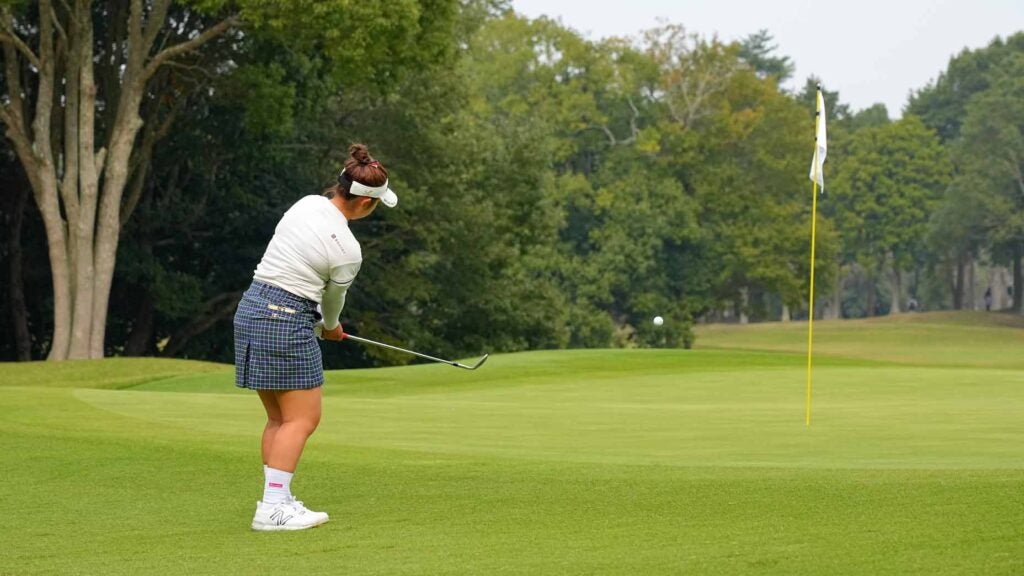Sure, staring down a long par-5 that measures over 500 yards can be menacing for many golfers, but a lot of times, the shortest shots are actually more intimidating.
That’s because shorter shots often call for more touch and finesse, requiring a player to dial in their distance control in order to have it stop as close to the hole as possible. Sometimes that means using a check and release, while other times it may mean trying a bump and run.
Regardless of what option you decide is best, when you’re capable of hitting a fantastic short chip shot, you’ll see a tremendous improvement in your scores. Yes, using a Texas wedge can be a good choice for short chip shots, but that’s not always a viable option depending on the conditions, course layout, etc. That’s why you must get comfortable hitting wedge shots from extra close.
To help get you there, here are 10 keys for mastering the extra short chip shot.
1. Grip it low
Placing your hands low on the grip of your club will effectively make your club shorter — which, by physics, will deliver less power.
Oftentimes, this is one way to tell if a golfer is going to make a smaller swing, which is necessary on these shorter chip shots.
2. Use a narrow stance
Similar to gripping it lower, narrowing your stance will help produce a smaller swing since it limits your body’s ability to move.
By doing this, it also allows you to be quite aggressive with your shots.
So I recommend putting your feet together so that they’re nearly touching, as this will limit both your flexibility and your backswing length.
3. Mirror a putting stroke motion
To help limit the size of your backswing on these shorter chip shots, I always suggest trying to mirror your putting stroke. By doing this, you’ll keep things short, allowing you to have more control of your shot.
The more you can equate this motion, the more it can help you intentionally control your swing size and distance.
4. Place your thumbs down
To help eliminate unnecessary swing speed, keep your thumbs pointing down to the ground throughout your backswing and follow through. This will also help limit too much swing size or hinge.
5. Use a slower backstroke
Many amateurs often make the mistake of taking the club back too fast and then trying to slow down as they approach impact. That’s never the way you want to hit a golf shot — especially not a short chip shot!
Since momentum is hard to stop, I suggest taking a slower backswing to feel more in control, as this will give you more awareness of the size of your motion.
6. Think ankle-to-ankle
Many golfers are visual learners, so one way that can help on these short chip shots is simply measuring your swing size relative to body parts.
Since you’ll want to keep the length of your swing small, try to feel the club more from ankle-to-ankle. By doing this, it can help create a smaller backswing and produce less speed and power.
You can place alignment sticks (available here) on the ground on both sides of the ball in order to measure your backswing size.
7. Smaller should equal slower
Smaller swings should always be slower, so don’t try to add something you don’t need.
Even if you happen to take a bigger backswing, simply allow the club to fall to the ground naturally, rather than trying to add false speed that you don’t need or want on these short chip shots.
8. This golf bag drill can help minimize the backswing
If you’re typically a big swinger, it can be tough to adjust to using a smaller swing on these types of shorter shots.
One way to help limit your backswing is by placing your golf bag behind you. The objective is to avoid making contact with the bag.
By creating a maximum swing limit in practice, you’ll help train yourself to duplicate that smaller swing when you’re out on the course.
9. Stop going back by going forward
As a teacher, I’ve found that many of my students often have larger backswings the more they try to focus on limiting it.
So another great way to limit your backswing is to start your forward swing sooner. By intentionally starting forward, you’ll avoid the urge of going too far back.
This isn’t only effective on short chip shots, but can also be used in the full swing as well.
10. Reverse grip — left hand low
If you have trouble controlling both your swing size and distance on chip shots, a tried and true method is using a similar grip to putting. This means placing the left hand lower (for right-handed players), which should make it difficult to take a large stroke.
I’m a big fan of doing this, as I’ve seen this work very successfully for my big swingers. If it works for putting, it certainly can work for short game shots!
